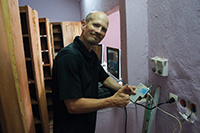 Sean O’Neil wanted to help the people of one of the poorest countries on Earth: Ivory Coast (Cote D’Ivoire) by creating a modern pharmacy that would allow them to get hold of the medicines they need to stay alive. Called the Emerging Business Builder Initiative, this is what Sean had to say in an interview with Martin Cooper:
Sean O’Neil wanted to help the people of one of the poorest countries on Earth: Ivory Coast (Cote D’Ivoire) by creating a modern pharmacy that would allow them to get hold of the medicines they need to stay alive. Called the Emerging Business Builder Initiative, this is what Sean had to say in an interview with Martin Cooper:
The goal is to deliver a modern pharmacy experience, one that would be familiar to anyone in the UK or the USA – a pharmacy that has supply chain management, back office, inventory management and a modern point of sale. It also has a loyalty programme – spend money to gain points that are redeemable against future products.
The entire pharmacy is run off two Raspberry Pis. One is used as a back-office ‘server’, the other is used at point-of-sale. The Pi was chosen not only for its low-cost but also because it has no moving parts – a great advantage when your environment is full of dust and small particles. The software is all open source so additional pharmacies can just buy their kit and download the relevant files to the Pis.

Sean with the back-office ‘server’ Pi
Powered through a consumer UPS unit to regulate the sometimes-iffy power from the main grid, the system synchronises data with the Cloud over the mobile network as a hard-wired Internet is just not something the country has in abundance. This has led to Sean developing a system which is very efficient in terms of data transmission – when your traffic is charged by kilobyte, there really is no other option.
The pharmacy has been of tremendous benefit to the village where it is located. No more 25 kilometre taxi rides to the next big town are needed!
You can read a full interview with Sean on the BCS website.

Thanks to Dr Emma Norling for spotting this one!









